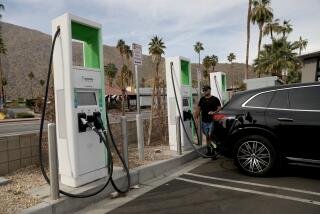New car import: buying habits
- Share via
Tighter credit, depleted retirement savings and environmental concerns are among the forces reshaping the U.S. auto market into something that looks more like Europe and the rest of the world -- where people buy smaller, more efficient cars and hold on to them longer.
Although every automaker is feeling the pressure, Chrysler, which filed for bankruptcy protection Thursday, and General Motors, which is on the road to taxpayer ownership, have been sideswiped hardest by careening change.
No one is expecting Americans to turn into a nation of fuel-sipping frugal pragmatists. But most analysts see little chance that the market will bounce back to its recent heights.
“Our entire business plan is constructed around the idea of being a profitable enterprise at a lower industry sales volume and a change in the mix of what’s sold,” said George Pipas, Ford’s sales analyst.
For many, buying a new car also has been a fashion statement. How else can you explain “why a single person with a dog tools around in a giant SUV?” asked Wesley Brown, a consultant with Iceology, a Los Angeles consumer research and consulting firm.
But the rate of emotional car purchases is slowing.
During a remarkable eight-year period starting in 1999, the nation devoured an average of 16.9 million new vehicles a year, a rate of nearly 5.9 autos for every 100 people, according to Edmunds.com, the auto industry information service.
Analyst Jesse Toprak of Edmunds.com estimates that U.S. new vehicle sales will struggle to reach the 10-million range this year -- a rate of just 3.5 per 100 people, and the lowest since 1963, the earliest year for which Edmunds.com has data.
Pent-up demand and improved consumer confidence as the economy recovers may slowly pull sales back to that 16.9-million mark by 2014, he said.
But many in the industry see annual sales leveling off at 14 million to 15 million.
Even if the industry could again hit nearly 17 million new-vehicle sales annually, that doesn’t look nearly as impressive after factoring in population growth. It represents a sales rate of barely 5.2 sales per 100 people. That is below the average rate of 5.7 for the 46 years from 1963 through 2008, Edmunds.com data show.
“You are starting to see signs that the U.S. market is more rational. Fuel prices combined with greater concern over the environment will play a larger role in the consumer psyche,” said John Mendel, executive vice president of automotive sales for American Honda Motor Co. in Torrance.
There will be fewer people like Edith Arevalo-Beatty, an insurance underwriter from Cypress who was looking at IS 250 and IS 350 sport sedans at Lexus of Cerritos on Saturday. “I get tired of having the same car after a while, and I want something new,” Arevalo-Beatty said as she eyed potential replacements for her 2007 Toyota Camry.
Instead, Sopanna Im, one of an estimated 30,000 Americans who bought new cars Saturday, more closely represents the changing face of the automobile business.
The Santa Ana dental assistant picked up a white Honda Fit -- about $17,000 out the door from Norm Reeves Honda Superstore in Cerritos Auto Square. It’s one of the smaller subcompacts, and it is a gas miser, getting about 27 miles per gallon in city driving.
“Pricewise, Hondas are good. They last a long time, and I was looking for something small that saves gas, especially with the economy right now,” Im said.
People are holding off buying new vehicles because of job insecurity. Others are using what would have been a car payment to replace retirement savings lost in the stock market.
Some want a new car but no longer have the home equity to tap for the purchase because of plunging real estate prices.
“Consumer spending habits have been changed by this economy,” said David Conant, chief executive of Conant Auto Retail Group, which owns Norm Reeves Honda, Cerritos Ford and six other Southern California dealerships.
The industry also faces other economic and demographic pressures, including:
* A need for fewer cars. As baby boomers age and retire, they won’t be keeping an extra vehicle for teen drivers, and some will try to get by with just one vehicle instead of two.
Mendel, the Honda executive, said that recent car scrapping rates and other data indicate there are some signs that the industry is undergoing what he called “de-contenting,” in which fewer people keep an extra vehicle for weekend trips to the beach or the lumberyard.
* Trading down. Aging baby boomers also will probably buy cars or vehicles built on a car chassis because they no longer need big vehicles to ferry their brood to soccer practice or Scout meetings. With her husband and driving-age children, Kathy Harrington, a teacher from Cypress, has five trucks and minivans. She was at Cerritos Ford on Saturday, where she was looking at the Focus, a small sedan that gets about 24 mpg in city driving. “We just need something smaller now,” Harrington said.
* Tighter credit. With home prices declining, fewer people can tap their home equity to finance a new car purchase. “The home-equity people bought a lot of cars from us,” said Fritz Hitchcock, who owns Puente Hills Toyota and several other dealerships.
During the real estate boom, home equity probably accounted for 1 million vehicle sales a year.
* Reliability. People who put off buying new vehicles for economic reasons are learning that modern vehicles last longer and consequently will delay future purchases.
Robert and Erika Paredes were wandering Norm Reeves Honda on Saturday, looking for a used car Robert thought would last a long time, have some panache and meet his budget.
Paredes liked the purr of the 197-horsepower engine in a 2007 Civic Si coupe. The Los Angeles computer tech worker figured “we could keep this car at least four, maybe five years.” He thought the sporty Civic’s style and power would hold its own with much of what’s on the new-car market and was a better deal.
Before the recession, someone would see a neighbor, friend or relative with a cool new car and decide they wanted one too. Easy credit, either through the banks or financial institutions funding car and real estate loans or automakers’ aggressive lease plans, made it easy to drive away in a new vehicle.
Now, people are learning that stretching a three-year car replacement cycle to four, or a four-year cycle to five, isn’t much of a sacrifice, Conant said.
“And if enough people do that, your car doesn’t look so old or outdated when you drop the kids off at school and you will wait longer to replace it,” he said.
Not every analyst believes the current tumult in the industry and the economy will unalterably change the U.S. auto market.
Brown, the Iceology consultant, has a more sanguine view, based mostly on his belief that the self-indulgent U.S. consumer just can’t resist the temptation of a shiny new car.
High gas prices or recessions can shock the system, changing what people buy in the short term or slowing sales, but whenever the problem eases, they “open up their wallets,” Brown said.
“We don’t see any sign that the fashion-statement importance of certain things such as autos, cellphones, sunglasses and sneakers has lessened for consumers. When we come out of this recession, that emotional need to buy will be just as strong,” Brown said.
And despite the restructuring going on in the industry, Brown thinks auto companies will eventually fall back into the bad habits of overproduction, steep sales incentives and lease subsidies and loose credit that got the business into trouble in the first place.
“It is just going to take a couple of boom years when a company is selling out of a model or two before they start to add capacity to meet that short-term demand, and then the economy turns down and we are back in that same old cycle,” Brown said.
“I would like to believe that the current situation will make both companies and consumers more pragmatic,” Brown said, “but I don’t think that will be the case.”
--







